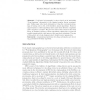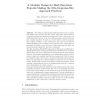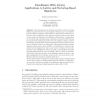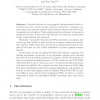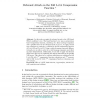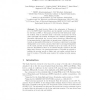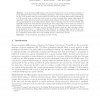116
Voted
ASIACRYPT
2009
Springer
15 years 7 months ago
2009
Springer
Code-based cryptography is often viewed as an interesting “Post-Quantum” alternative to the classical number theory cryptography. Unlike many other such alternatives, it has th...
103
click to vote
ASIACRYPT
2009
Springer
15 years 7 months ago
2009
Springer
The design of cryptographic hash functions is a very complex and failure-prone process. For this reason, this paper puts forward a completely modular and fault-tolerant approach to...
ASIACRYPT
2009
Springer
15 years 7 months ago
2009
Springer
An r-collision for a function is a set of r distinct inputs with identical outputs. Actually finding r-collisions for a random map over a finite set of cardinality N requires at ...
124
click to vote
ASIACRYPT
2009
Springer
15 years 7 months ago
2009
Springer
We look at iterated power generators si = se i−1 mod N for a random seed s0 ∈ ZN that in each iteration output a certain amount of bits. We show that heuristically an output of...
107
click to vote
ASIACRYPT
2009
Springer
15 years 7 months ago
2009
Springer
In this paper we present two related-key attacks on the full AES. For AES-256 we show the first key recovery attack that works for all the keys and has 299.5 time and data complex...
115
click to vote
ASIACRYPT
2009
Springer
15 years 7 months ago
2009
Springer
We demonstrate how the framework that is used for creating efficient number-theoretic ID and signature schemes can be transferred into the setting of lattices. This results in cons...
100
click to vote
ASIACRYPT
2009
Springer
15 years 7 months ago
2009
Springer
Abstract. Physical attacks on cryptographic implementations and devices have become crucial. In this context a recent line of research on a new class of side-channel attacks, calle...
ASIACRYPT
2009
Springer
15 years 7 months ago
2009
Springer
In this work, we apply the rebound attack to the AES based SHA-3 candidate Lane. The hash function Lane uses a permutation based compression function, consisting of a linear messag...
ASIACRYPT
2009
Springer
15 years 7 months ago
2009
Springer
The hash function Skein is the submission of Ferguson et al. to the NIST Hash Competition, and is arguably a serious candidate for selection as SHA-3. This paper presents the firs...
94
Voted
ASIACRYPT
2009
Springer
15 years 7 months ago
2009
Springer
Group encryption (GE) schemes, introduced at Asiacrypt’07, are an encryption analogue of group signatures with a number of interesting applications. They allow a sender to encryp...
